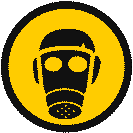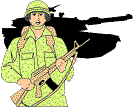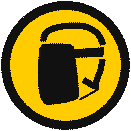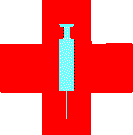 | Chemical Weapons: Nerve Agents |  |
 | Chemical Weapons: Nerve Agents |  |
 You may have read newspaper or
magazine articles about the possible use of chemicals during a war or a
terrorist attack. Many of these chemicals affect the nervous system and
are therefore called nerve agents. Nerve agents
are similar to insecticides and they can be deadly if people are exposed
to them. Unfortunately, this has already happened. On March 20, 1995,
twelve people were killed and over 5,000 were injured when a nerve gas
called "sarin" was released in the Tokyo subway system. People may have
also been exposed to nerve agents during the conflict ("Gulf War") in the
Middle East. It is possible that many countries have access to these
dangerous weapons and future human exposure to these chemicals is
possible. In fact, the nerve
agent "VX" is suspected in the attack and death of Kim Jong Nam,
half-brother of North Korean leader Kim Jong Un in February, 2017. You may have read newspaper or
magazine articles about the possible use of chemicals during a war or a
terrorist attack. Many of these chemicals affect the nervous system and
are therefore called nerve agents. Nerve agents
are similar to insecticides and they can be deadly if people are exposed
to them. Unfortunately, this has already happened. On March 20, 1995,
twelve people were killed and over 5,000 were injured when a nerve gas
called "sarin" was released in the Tokyo subway system. People may have
also been exposed to nerve agents during the conflict ("Gulf War") in the
Middle East. It is possible that many countries have access to these
dangerous weapons and future human exposure to these chemicals is
possible. In fact, the nerve
agent "VX" is suspected in the attack and death of Kim Jong Nam,
half-brother of North Korean leader Kim Jong Un in February, 2017.
History
 Most nerve agents belong to a group of
chemicals called "organophosphates". The first of these chemicals was
made in 1854 and was originally developed to be used to control insects
and save crops. The first nerve agent (called "Tabun" or "GA") for
military use was made in Germany in 1936. Another nerve agent, "sarin" or
"GB," was made in 1938 and "Soman" or "GD" was made in 1944. It appears
that these nerve agents were not used by the
Germans during World War II. However, it has been estimated that the
Germans had stockpiles of tons of both Tabun and Sarin. The United
States and Russia continued producing and stockpiling these nerve agents
after the War. In the 1950s another nerve agent, "VX," was produced in
England.
Most nerve agents belong to a group of
chemicals called "organophosphates". The first of these chemicals was
made in 1854 and was originally developed to be used to control insects
and save crops. The first nerve agent (called "Tabun" or "GA") for
military use was made in Germany in 1936. Another nerve agent, "sarin" or
"GB," was made in 1938 and "Soman" or "GD" was made in 1944. It appears
that these nerve agents were not used by the
Germans during World War II. However, it has been estimated that the
Germans had stockpiles of tons of both Tabun and Sarin. The United
States and Russia continued producing and stockpiling these nerve agents
after the War. In the 1950s another nerve agent, "VX," was produced in
England.
Breathing a lethal dose or getting a lethal dose on the skin can kill in only a few minutes! To get an idea of how deadly these chemicals are, do the math.
1 kilogram = 1,000 gm = 2.2 lbs 1 gm = 1,000 mg = 0.0022 lbs 10 mg = 0.000022 lbs10 mg (0.000022 lbs) is not much more than a single grain of rice!!
Method of ActionAcetylcholine is a common neurotransmitter found in the central and peripheral nervous system. Acetylcholine binds to receptors on the other neurons and muscles. In the peripheral nervous system, acetylcholine is located at the "neuromuscular junction" where it acts to control muscular contraction. Acetylcholine is also used in the autonomic nervous system. The action of acetylcholine is stopped by an enzyme called "acetylcholinesterase" (AChE).
Nerve agents bind to part of the AChE molecule. This
makes the AChE inactive and blocks the
action of AChE. Therefore,
The Acetylcholine Synapse
Symptoms of Nerve Agent Poisoning Nerve agents attack all synapses that use acetylcholine as a
neurotransmitter...this means both the central and peripheral nervous
systems are affected. Symptoms of nerve agent poisoning include:
Nerve agents attack all synapses that use acetylcholine as a
neurotransmitter...this means both the central and peripheral nervous
systems are affected. Symptoms of nerve agent poisoning include:
Treatment for Nerve Agent Exposure Immediate
treatment of person
who has been exposed to a nerve agent exposure includes a complete washing
of the eyes and skin with water. A diluted (0.5%) bleach solution should
also be applied to the skin if possible. Immediate
treatment of person
who has been exposed to a nerve agent exposure includes a complete washing
of the eyes and skin with water. A diluted (0.5%) bleach solution should
also be applied to the skin if possible.Two drugs, atropine and pralidoxime chloride, have been used as antidotes for nerve agent poisoning. Atropine works by blocking one type of acetylcholine receptor so that the acetylcholine that is already in the synapse cannot work. Pralidoxime works by blocking the binding of the nerve agent to the AChE. Both of these drugs were issued to US troops during the Persian Gulf War in the form of an antidote kit called the Mark I. Diazepam (Valium) may be used to reduce convulsions and seizures brought on by exposure to nerve agents.
Effects of Atropine
| |||||||||||||||||||||||||||||||||||||||
|
| BACK TO: | Exploring the Nervous System | Table of Contents |
![[email]](./gif/menue.gif) Send |
 Get Newsletter |
 Search Pages |
 Donate to Neuroscience for Kids |